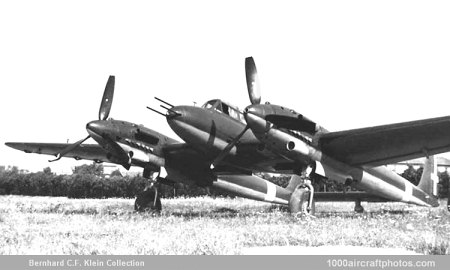03/31/2013. Although twin-fuselage or twin-boom combat aeroplanes were relatively commonplace during the WW I, the popularity of this configuration languished during the 1920s and early 1930s until, in 1936, the Fokker G.1 twin-boom fighter-bomber appeared at the Salon International de l'Aéronautique in Paris, and interest in the possibilities of this layout was revived. The twin-boom monoplane never achieved universal acceptance but it offered certain advantages over more orthodox configurations, perhaps the most outstanding example of this arrangement being the Lockheed P-38 Lightning.
Among the combatants which examined the twin-boom configuration was Italy, and when in 1941, the Ministero dell'Aeronautica issued a specification for a two-seat multi-purpose machine suitable for the long-range escort "destroyer", high-speed reconnaissance, and fighter-bomber roles, two of the competing aircraft manufacturers adopted the twin-engine, twin-boom layout. The specification demanded, among other things, a considerable operational radius coupled with an exceptionally heavy forward-firing armament, and maximum speed and service ceiling comparable with those of the leading contemporary single-engined, single-seat fighters, maneuverability being of secondary importance, and the competing aircraft were the heaviest and most powerful fighters evolved by the Italian aircraft industry.
Competing for production orders were the Caproni Aeronautica Bergamasca and the Societa Italiana Aeroplani Idrovolanti Savoia-Marchetti, the former concern developing the Ca.380 Corsaro and the latter producing the SM.91 and the SM.92, all three prototypes being powered by the 1,475 hp Daimler-Benz DB 605A-1 twelve-cylinder liquid-cooled inverted V-engines. The SM.91, considered as Italy's answer to the de Havilland Mosquito, was flown for the first time on March 10, 1943, and was an all-metal monoplane carrying two crew members in a central fuselage nacelle.
An extremely heavy forward-firing cannon armament was installed, comprising three 0.787 in (20 mm) Mauser MG 151 cannon in the fuselage nose and two MG 151 cannon in the wing roots, each with 300 rounds. For the fighter-bomber and dive-bomber roles four 220 lb (100 kg) or 353 lb (160 kg) bombs could be carried externally, two on racks beneath the central nacelle and two on racks under the wing center section. Alternatively, a single 1102 lb (500 kg) bomb or a 211 gal (800 l) long-range tank could be carried.
Only one prototype of the S.M.91 was completed, and limited flight testing was undertaken with this machine.
